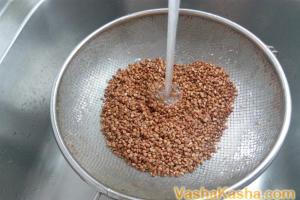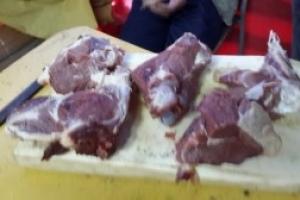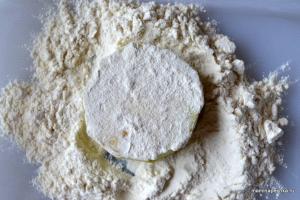There is nothing more environmentally friendly and original than a wooden structure. The house can be made of rounded and profiled timber.
In order for a building made of such building material to serve for many years, high-quality interior finishing is carried out. timber house.
All finishing work in a wooden building is divided into: external and internal finishing of a timber house. If the outside of a house made of wood rarely needs finishing, since it can significantly spoil the appearance of the structure, it can strengthen and insulate the walls of the house.
There are various options interior decoration houses made of timber.
It could be:
- Decorative rock.
- Block house.
- Plastic lining.
- Panel siding.
- Wooden lining.
- Drywall and much more.
Photos of the interior decoration of a wooden building are very diverse. Very often in finishing works Ah, more than one material is used.
There are interesting and original designs premises that amaze with their practicality.
Decorative stone in the decoration of a wooden house

The interior decoration of a log house can be done with decorative stone. This design of the room looks very original and aesthetically beautiful.
Since walls made of profiled timber have a fairly flat surface, the cost of leveling them will be insignificant.
Main characteristics of the material:
- Decorative stone is an analogue of natural stone.
- It is moisture resistant and very durable.
- Although it is not made from natural substances, decorative stone is still environmentally friendly.
- With its help, unique and original interiors wooden buildings. Stone and wood have long been used in decoration.
They look very original together. - Surface decorative material unable to absorb a variety of contaminants. It is easy to clean. To do this, it will be enough to use a damp rag.
Advice. the surface cannot be cleaned decorative stone using abrasives. It can be damaged and the appearance of the material will simply deteriorate.
What needs to be considered during installation work
So:
- Artificial stone is very easy to install. To do this, you will need to make some preparatory work.
Since wooden walls made of profiled timber will have small cracks that were formed as a result of masonry, you need to caulk using flax thread or use moss for this purpose. - All the cracks are properly sealed and only after this can we begin finishing work on the wall surface.
- Decorative stone lies on a flat surface. Since it is light in weight, it will not need to be pre-mounted on the wall surface. reinforcing mesh made of wire and construction mesh for plaster, which cannot be said about natural stone.
- You can level the surface of a wooden wall using drywall or plaster. Sometimes used for such purposes thin sheet plywood or OSB.
- Plaster is applied to wooden walls quite simply. It is sold in bulk form.
- In order to obtain a high-quality solution, you need to dilute it with a certain amount of water. For this purpose, there are special instructions on the packaging, according to which such actions are carried out.
- There is a starting and finishing plaster. They cannot be interchangeable, since they perform only those functions that are assigned to them.
The starting plaster serves to level the surfaces, and the finishing plaster performs decorative functions and hides defects in the starting layer.
Advice. It can also be used to level surfaces wooden walls drywall. It is attached to the profile metal carcass.
That is, it turns out to be a kind of lathing on which sheets of drywall are attached.

To install decorative stone you need:
- Special glue or cement mortar.
- Decorative rock.
- Two spatulas (small).
- Level.
- Putty (if necessary).
Styling:
- The entire installation process will depend on the size of the finishing material itself. Adhesive or cement mortar is applied to inner surface stone and onto the wall using a spatula.
The second spatula removes excess solution from the surface of the material. Decorative stones need to be fastened close to each other. But it all depends on what type of masonry was chosen. - Each element of such finishing must be laid strictly according to level. Of course, there are sizes of stones that are stacked in a chaotic manner.
Then you will need to measure the required finishing area and outline it on the surface. - After installing the decorative stone, all seams can be sealed using special means, or you can add dyes to the solution and do the laying and finishing of the surface at the same time.
The video shows an example of installing decorative stone. Anyone can cope with such work.
Wooden lining and block house in the decoration of a wooden house
The interior of the profiled timber can be made using wooden lining or a block house.
These materials are similar in their technical characteristics. They create design integrity.
Distinctive features:
- But, before using such materials, you need to take into account the fact that wood absorbs moisture quite well and it is for this reason that you should not use them in rooms where there is high air humidity.
- Finishing materials of this type are distinguished by their environmental friendliness and practicality. They look great in a wooden structure.
Their surface is very protected from various contaminants and insects. As a rule, it is varnished. - The materials are quite strong and durable. Most often they are used to decorate a living room or bedroom.
They combine very interestingly with decorative or natural stone.
To install a wooden lining or block house you need:
- Self-tapping screws for wood.
- Screwdriver.
- The material itself.
- Level.
- Wooden bars.
A starting wooden strip is first installed on the wall surface. The material itself is already being installed on it.
It will be possible to make a wooden sheathing and place insulation in its cells. In this way, insulation and finishing work will be carried out simultaneously.
Plastic lining and siding in the design of wooden walls

Very often, the interior decoration of houses made of timber is carried out using plastic or siding. The materials are moisture-resistant and it is for this reason that they are used in the kitchen and sanitary areas.
Distinctive features:
- The surface of such materials is not able to absorb dirt and therefore it is very easy to clean.
- They are also characterized by their easy installation and it is possible to carry it out yourself and without resorting to the help of a specialist, which will significantly save the family budget.
- Price for these Decoration Materials quite affordable compared to wooden clapboard or decorative stone.
For installation you will need:
- Small wooden blocks and boards.
- Wood screws with long and short legs.
- Screwdriver.
- Sealant.
Installation:
- Decorating the inside of a timber house using siding or plastic begins with the manufacture of sheathing. They are mounted from wooden boards and bars directly on the wall surface.
It is attached using self-tapping screws with long legs. All elements are self-tapping screws with small legs. - As soon as the sheathing is ready, fastening the materials begins with the installation of a starting strip, which covers the entire direction of the material. Strips of plastic or sheets of siding are already inserted into it during the process.
Can be fastened together individual elements construction stapler.
Advice. To give strength to the entire finish, each joint of these materials must be treated with a sealant.
The use of plasterboard in finishing a wooden structure

Drywall has been used for many years in almost all finishing works.. With its help, not only surfaces are leveled, but also various ceiling structures are constructed.
The interior finishing of a timber house with plasterboard will be practical and durable.
Advice. It is not recommended to use drywall in small rooms, as this finishing method can hide the space.
To install such finishing material you will need:
- Metallic profile.
- Drywall sheets.
- Self-tapping screws with wide heads.
- Screwdriver.
- Dowels.
- Hammer.
Installation:
- Decorating the inside of a house made of timber using plasterboard begins with the construction of the frame. It is made of a metal profile, which is attached to the wall surface using dowels.
- Drywall sheets are mounted on this frame using self-tapping screws and a screwdriver. Fit right size won't make a sheet a lot of work.
This material is cut with a regular stationery knife. - After this, the joints of the sheets are treated with putty and the surface can be painted or pasted over. Very often decorative plaster is applied to it, which gives the room a rich look.
Well, it's finished!
As a rule, finishing houses made of timber is not difficult. To do this, you will only need to choose the right finishing material, and you can carry out all the work yourself.
There is nothing complicated about this today.
Wooden houses themselves look impressive. From the point of view of heat preservation, they do not need interior decoration. But not everyone likes the yellow-brown monotony in the interior of their home. Fortunately, the construction market offers a lot of materials for interior finishing of a house made of timber - you just need to spend some time studying the issue and you will definitely choose the right option for yourself.
House made of timber in modern design
Features of wooden houses
The interior decoration of a house made of timber is not fundamentally different from a brick or block frame. You just need to take into account a few features:
complete shrinkage of the log house lasts several years;
over time, the gaps between the beams expand;
wood requires mandatory protection from moisture.
Because of such nuances, you cannot rush to begin interior decoration, otherwise cracks will appear in the walls and ceiling. To avoid troubles, it is necessary to coat the wood with a protective varnish in the first year after construction of the frame.
Builders advise following a certain order when finishing a wooden house:
Laying engineering communications on top of the subfloor
Main flooring flooring
Treatment of timber (filling cracks, filling, applying antiseptic, decorative finishing)
Ceiling decoration (puttying and varnishing of beams, installation of finishing coating)

The advantage of laminated veneer lumber is that it shrinks less than other types of wood.
In a new house, it is better to leave the original appearance of the timber - environmentally friendly, natural, smooth. And if the log house has stood for several decades, then it is advisable to cover it from the inside with modern finishing materials, since restoring the appearance of the tree will be difficult and expensive.
Types of interior decoration
Glued laminated timber does not require additional cladding. It looks perfect even without varnishing. If the walls are made of profiled wood, you will have to think about finishing.
Wood needs protective impregnation in any case. It creates a barrier against fungus, mold, moisture and even fire. Can lighten or leave the surface color unchanged.
Low-quality profiled timber can be easily hidden under panels that imitate natural wood from lining, block house or siding - this way the inside of the house will not only maintain eco-style, but will also become warmer.
Create in a wooden cottage modern interior also real. The timber can be easily sheathed with plasterboard or OSB panels, painted, covered with wallpaper, or covered with artificial stone. And hide the electrical wiring inside.

Imitation of real timber in the living room
Floor installation
Before you start finishing work, be sure to think over the design of a house made of timber: the interior decoration of the house directly depends on the project. Based on it, the cost estimate is calculated.
A conscientious construction company has specialists in 3D interior design, estimators, and experienced installers. They will quickly and efficiently fulfill all your wishes, making your dreams come true.
Installation begins with the subfloor. Regardless of the finishing materials chosen, the surface of the lag is first treated with protective impregnation against moisture. Insulation (mineral wool or polystyrene foam) is placed between them. Then a substrate made of chipboard or OSB board is attached. And a finishing coating is already laid on top of it. It can be natural board, linoleum, laminate, parquet or artificial stone.
An added plus! Double flooring will help keep the house warm.
Popular floor coverings
In a wooden cottage, the floor is often laid with planed tongue-and-groove boards made of pine or spruce. It does not require maintenance and retains its original appearance for several decades. And when it gets dark, you just need to sand it down upper layer and re-coat with a protective compound.

Tongue and groove board without varnish coating
On our website you can find contacts of construction companies that offer. You can communicate directly with representatives by visiting the “Low-Rise Country” exhibition of houses.
The only contraindication is the installation of heated floors. This is a fire hazard and impractical, because most of energy will be spent on heating the wood.
Laminate and parquet conduct heat well. These coverings look similar to plank floors, only with a more interesting pattern. You can create an original pattern from parquet planks. And the laminate is strong enough, it is not pressed through by heels and furniture legs. Imitates different types of wood, metal and stone.

Laminate with imitation stone in wooden house
Artificial stone on the floor enhances the interior. It is best to install this material in the bathroom, hall or kitchen. To keep your feet from freezing, a heating system is needed. The main advantage of a stone floor is its durability and unique pattern. This type of floor design requires plaster and stone on the walls and ceiling.

Artificial stone on the floor looks luxurious
Linoleum is the most affordable wood imitation. Its service life is no more than 10 years, so it is often installed as a temporary covering.
Wall decoration
Wooden walls are first impregnated with an antiseptic, and then treated with varnish, paint, mastic or oil. Choose a solution based on the expected effect. If the surface needs a tinted matte finish, then mastic or acrylic paint. For an elegant gloss, the timber is coated with oil or varnish. The texture of the wood does not change from such solutions, but moisture is not a problem in the coming years. Wax-based mastic has a porous structure that allows air to pass through, and oil gives a beautiful golden shine.
When the impregnation has dried, the finishing of the house from the profiled timber from the inside begins. Needed for lining wooden sheathing. Steam and heat insulating sheets are placed in the spaces between the slats. The boards themselves are nailed to the slats at the edges. And they are connected to each other using grooves. The lining can be placed vertically, horizontally or diagonally. If you combine these methods, you will get a unique drawing.

Lining on the wall is ideal in a wooden house
The lining is made from different breeds wood (spruce, pine, aspen, linden, alder). This affects shades, heat resistance and strength. The material class should also be taken into account:
C-class is of low quality (with gaps, dark spots and knots);
B-class of average quality (there are some knots);
A-class of high quality (there are knots, but they look aesthetically pleasing);
extra class (ideal material without defects).
There is a popular type of lining called block house. Planed board, the outer side of which imitates timber or logs. The groove-shaped side fastening reliably connects the parts together. They are laid horizontally, starting from bottom to top. Made from coniferous species tree. Ideal for finishing walls made of low-grade profiled timber. Does not require additional protection.

A block house cannot be distinguished from a rounded log from afar
Another finishing material that builders like to use to finish a wooden house made of timber is plasterboard. It is universal, inexpensive and easy to install. It is attached to aluminum or wooden profiles, which are easily screwed to the beam. In the free space you can lay insulation and hide electrical wiring. The sheets themselves are mounted with self-tapping screws. Then they are plastered and the finishing coat is applied. For example, wallpaper, self-adhesive paper, ceramics or paint. Niches, arches, and shelves in the wall are created from plasterboard, if there is such a need. The design is 10 cm thick, so it is better not to use this material in a small room. But as a partition it is an ideal option.

Unusual plasterboard arch
Siding and plastic lining are also actively used in finishing work. These materials are cheaper than natural wood, but their texture is very similar to it.
Siding panels are mounted horizontally. You can choose the color and texture to suit your taste: wood, brick, metal or stone.
Plastic lining (PVC panel) with a standard width of up to 10 cm, and inside consists of honeycombs. Air voids improve the insulation of a home. The vinyl surface does not require varnishing, is not afraid of moisture and sun, and its colors are amazing - from monotonous white to bright flower bouquets. Mounted plastic lining on a metal frame. This material is suitable for the corridor, bathroom and living room. You can sheathe the entire room or just the basement part.

Artificial stone is made from essential resins and natural chips. It looks like the real thing, but is cheaper and lighter in weight. In texture and color it is identical to marble, crushed stone, brick, shell rock, granite, etc. It is attached to the sheathing with a special glue. Goes well with chalet style plaster. It is better to entrust installation to professionals, then the tiles will be glued without gaps and will last a long time. Decorative stone is suitable for accenting in the bedroom, living room, hallway and kitchen.

Accents in the living room made with artificial stone
These are the main materials for finishing the inside of a timber house. They create an interior in Old Russian, classical or modern style. For the ceiling great solution will become a tension fabric. Matte film will fit even into a country room. Drywall or lining is also often used in a wooden house.
Prices in Moscow for interior decoration of a house
What budget should the owner of a wooden house expect for a construction company to complete the interior finishing? It all depends on the complexity and volume. On average, an installation team in Moscow asks for 80 rubles/sq.m. for applying impregnation in one layer. m., oils – 100 rub./sq. m, varnish or wax – 150 rub./sq. m. Painting the inside of a log house will cost 200 rubles/sq.m. m. Plus the cost of the solutions themselves.
Installation of an aluminum frame for any finishing panels - 300 rub./sq.m. Covering a room with plasterboard – 300 rub./sq.m. vinyl siding or panels without insulation - 600 rubles/sq.m, and with insulation - 700 rubles/sq.m. Plus the material itself.
What and how much in finishing a wooden house - look at the video:
Installation of block house panels is a little cheaper - 450 rubles/sq.m. excluding lathing and related work.
Cost of sticking to the wall artificial stone– minimum 1200 rubles/sq.m, but this is if the surface is already prepared. The cost of turnkey work is at least 10,000 rubles/sq.m.
Laying tongue-and-groove floorboards will cost 600 rubles/sq.m including joists, parquet without sanding – 600 rubles/sq.m, laminate or linoleum – 250 rubles/sq.m.
Covering the ceiling with clapboard costs from 500 rubles/sq.m., plasterboard – 450 rubles/sq.m. And installation of stretched PVC fabric will cost from 550 rubles/sq.m. excluding material.
Example designer finishing houses made of timber, watch the video:
Unusual options for finishing a wooden house
Even from familiar materials you can make original design wooden house inside. Like, for example, a clapboard ceiling with carved elements.

Or a silhouette Japanese wood from stones on the wall. The base is covered with the same tiles.

Parquet in in capable hands- a real work of art. No carpet needed.

Unique pattern from parquet boards
Conclusion
A wooden house itself creates an atmosphere of comfort and unity with nature, and modern finishing materials help to maintain it. The main thing is professional and high-quality work on the interior decoration of the house - then the next repair will not be needed soon.
The interior decoration of a timber house depends depending on the time of construction, the size of the house and the type of timber, from which the structure was erected. All these factors influence shrinkage.
The wooden parts of the subfloor are carefully treated with an antiseptic. Then you need a layer of waterproofing. The waterproofing layer is made from rolled materials, rolling out overlapping strips. The next step is laying insulation between the floor joists.
Between wooden floors and walls leave a gap for the movement of the tree. Without technological gap the floor, expanding, will rest against the wall. A stressed tree will form bumps, the locks will rise and move apart. Additional purpose of the technological gap – ventilation underground space . The baseboard is attached to the wall, without preventing the wood from expanding and contracting as the humidity of the room changes.
Sheet material is used in work area kitchens, bathrooms, bathrooms as a base for ceramic tiles.
Laying tiles according to wooden base has its own characteristics:
- the base is checked for creaking, mobility, disassembled and strengthened for any of the signs;
- the surface is primed before starting work;
- use glue with polymer additives or glue for wood tiles, improving the adhesion of the tile to the surface.

Ceilings
The principle of constructing a house floor from wooden beam coincides with the principle of floor construction. The result is a warm and strong multi-layer cake of sheathing and insulation, lined with vapor barrier and waterproofing films.
The ceiling is carefully insulated; the main heat loss in the house comes through the roof. The top cladding is carried out at the stage of building a house, called rough ceiling. The lower surface of the ceiling visible from the room is called bound.
Ceiling beams give the ceiling of a timber house a non-standard original form, give a lot of scope for imagination. Ceiling beams usually remain visible decorative element. The beams are painted with wood impregnations or sheathed with a variety of materials, decorating and decorating them.
To decorate the ceiling use:
- stretch ceiling , glossy, matte and patterned. Stretch ceilings are not afraid of shrinkage, the fabric is elastic and stretches well;
- sheets with subsequent painting. LED Strip Light will allow you to adjust the shade of lighting according to your mood;
- wooden lining, painted in light shades for color contrast with dark ceiling beams or in the same color;
- laminated panels made of fiberboard, MDF, light and varied in color and pattern;
- plastic panels for bathrooms, bathrooms, utility rooms.

Stretch ceilings are not designed for minus temperature, are applicable only in houses equipped with heating. Otherwise, finishing the ceiling of a house made of timber is no different from finishing the ceiling of any other house or apartment.
note
Hemming device ceiling beams reduces the height of the room.
Walls
The excellent wood texture of the walls made of coniferous timber does not require finishing, it looks natural. Wood is a universal material used in any style from modern to country. Wooden walls look appropriate in combination with stone and forged elements, stainless steel and glass, organically fitting into the interior design.
Unaesthetic timber joints are covered with decorative cord. A smooth, even surface is covered with colorless transparent paint and varnish compositions or lightly tint while maintaining texture. Lucky on water based will preserve wood and a pleasant pine aroma.
If the surface of the beam has a large number of defects, cracks - the surface is finished with any materials without restrictions.
The walls of a timber house are finished with:
- plaster, smooth or embossed, followed by painting or wallpapering;
- plasterboard sheets with any finishing;
- wooden clapboard, block house, imitation timber. The higher the grade of wood, the fewer knots.
 The lining will preserve the ecological style of the premises and hide the shortcomings of the timber.
The lining will preserve the ecological style of the premises and hide the shortcomings of the timber.
For fastening to the walls, a block with a cross-section of 40 x 40 mm is nailed or screwed with self-tapping screws. The block is placed perpendicular to the sheathing boards.
The lining is secured to the bars by hammering finishing nails into the lock at an angle or using special metal fastenings, clamps.
If necessary, insulation made of or mineral wool is laid between the bars. Interesting effect log walls creates semicircular block house shape. After installation, the lining is painted according to the design of the room.
The height to the ceiling is also left expansion gap to the expansion of wood when changing temperature and humidity conditions and possible shrinkage of walls.
note
A frame made of timber or profile reduces the area of the room.
Finishing with plasterboard sheets will hide electrical wiring and pipes utility networks. Drywall is easy to putty and bend to give it a semicircular shape.
In rooms with high humidity use moisture resistant drywall. The sheets are durable and will withstand the weight of tiles and stones.
Stone brings to the interior natural beauty, comfort, harmoniously combines with wood. Rough texture natural stone unique, suitable for highlighting the fireplace area, framing doorways, corners of the room.
Artificial stone is lighter and does not reinforce the wall with mesh when laying it. Tiles correct form, equal thickness, easier to install.
Rooms decorated with artificial or natural stone are brightly lit. A lack of light will make the interior rough and gloomy.
Interior decoration of timber houses in the photo









The design of the premises reflects inner world inhabitants. Classic or modern, ecological style or country - the interior decoration of a house made of timber is limited only by the preferences of the owners.
Houses made of timber are a very popular type of structure. The timber is easy to install due to its rectangular profile; such buildings are quickly erected, so this construction material occupies a leading position in the wooden house construction segment. In temperate and northern latitudes, timber is usually insulated and covered.
Features of timber buildings
Houses made of profiled timber do not differ in construction technology from log houses. The material itself is very attractive. The building is made of natural wood with a beautiful grain pattern and looks organically against the backdrop of the natural landscape. For low-rise private construction, sawn, glued and profiled timber is used, which determines the installation technology. Timber structures are different environmental safety, this material is breathable.



The cross-section of the material ranges from 10 to 20 centimeters. The cross-sectional size is the thickness of the walls. For cold climates this is clearly not enough, so the walls outside and inside have to be insulated so that the final thickness of the walls is at least 40 centimeters for a temperate climate. There is a need to cladding facades with insulation, which is carried out various materials, corresponding to the style of construction. Disadvantages include the ability of wood to absorb moisture, the tendency to form corrosion from excessive moisture, and high flammability. Exterior decoration designed to reduce the influence of negative atmospheric factors, insulate and increase the safety of the home.


Suitable finishing time
The finishing of the facades begins after the final shrinkage of the frame. Porous wood fibers absorb and release moisture, this deforms and slightly changes the size of the wall, even if the wood was well dried before construction. Timber structures undergo shrinkage from several months to two years. The construction season also affects the shrinkage time: construction in winter will require 7–8 months, in summer – at least 12 months. The most intense deformation process is observed in the first three months.


There are some differences in these terms for different materials. Exterior finishing construction of a house made of laminated veneer lumber can begin within three months after construction, since this material was dried using special technologies in production and is not affected by atmospheric moisture and does not deform. Due to the gluing of the timber, the wood fibers do not twist along their length. Rounded and sawn timber do not have these qualities, since the densest wood of the outer layer of the log is cut off during processing. This reduces moisture resistance and makes the timber vulnerable to rot and fungus. Experts recommend choosing the time of late autumn - early winter for construction due to the low cost of construction, then in the summer it will be possible to begin installing windows, doors, exterior and interior decoration without fear of cracking the cladding.

Types of materials
A finished timber frame can be clad on the outside with various types of finishing: stone, bricks, plastic or metal siding, flexible ceramics. You can use false timber. Each option has both advantages and disadvantages. The most expensive and durable finishing material is natural decorative stone; its installation requires special professional skills. Stone tiles are glued to the facade using the same technology as tiles in a bathroom or sauna using moisture-resistant components adhesive composition. A natural stone- This is a heavy material, so installation may require special fasteners to provide strength. More often, only the base of the building and some parts of the wall or a porch with columns are finished with stone.

It is better to use artificial decorative stone. In terms of aesthetic qualities, it is in no way inferior to the real thing, and in terms of operational properties even surpasses it. The front surface of artificial stone imitates any natural mineral, more resistant to adverse mechanical influences. Its price is slightly lower, but it is also an expensive finish. The compensation will be a long service life and a solid appearance of the house, the ability to choose any shade of stone.


A common technique to cover timber brickwork. It increases the cost of construction several times, but the house will receive necessary thermal insulation. The service life of the building will increase significantly, and the flammability rate will decrease. Such houses are preserved indoors comfortable conditions even in the northern regions. Cladding the entire structure, even half a brick, will require strengthening the foundation and professional bricklaying skills.

A popular lightweight option is decorative facade clinker tiles, which looks aesthetically pleasing in combination with wood. It has variations in thickness, appearance and size. During the manufacturing process, firing takes place, and the corner elements are made using the extrusion method, this extends the service life of the finish to several decades. Clinker tiles have irregularities on back side, due to which there is good adhesion to the wall surface. Front side imitates not only different kinds minerals, but also bricks with a different range of shades.

Trimmed and not edged board, false beams, wooden slats, block houses are the most common finishing materials in private wooden housing construction. Good thermal insulation properties, the aesthetics of rural style and the beauty of natural wood attract the attention of consumers. The block house allows you to imitate structures made from solid logs. A wooden strip and edged board neatly hide the insulation and do not disturb the naturalistic natural style and are affordable and easy to install. Often wood trim complemented by carvings, which greatly decorate buildings in the Russian style.




Separately, you should pay attention to unedged boards. This material costs pennies. But a façade properly sheathed with unedged boards turns the house into a work of art. The board or slab is cleared of bark, the facades are sanded and sewn up. Rough finishing gives the building a rustic feel and becomes an aesthetic accent. Firing the wood adds decorativeness while simultaneously increasing the durability and strength of the material.
In front of everyone positive qualities Natural wood is not moisture resistant enough and is susceptible to fungus. The replacement was plastic and metal siding. Metal siding is more suitable for industrial buildings, but can also be used in civil engineering. Modern technologies allowed us to give good specifications these materials: durability, moisture resistance, pigment resistance, variety of designs, lightness self-installation, affordable price category. A neat and aesthetic appearance of the house is guaranteed for ten years or more.

Flexible ceramics has become a new, technologically advanced material. The basis is clay with polymers. Flexible ceramics are characterized by durability, do not fade in the sun, are very convenient to use, moisture-resistant and durable. This roll material and cladding is similar to wallpapering. They can be used to cover structures with round shapes - columns, arches, vaults, domes. Due to the presence of clay in the composition, it has breathable properties, but still for most finishes it is wooden frame You need ventilated facade insulation.

A plastered facade is a simple and decent finish for external walls. The work is simple, but labor-intensive, and not difficult to master. He is good fire protection, easy to repair. The plastered facade can be combined with any design style. It can be painted or decorated with decorative plaster.


There are the following types of decorative plaster:
- mineral is a durable cement mixture that is resistant to the formation of fungus and mold;
- silicate is made from liquid potassium glass. It is considered a breathable and durable material;
- acrylic is made from synthetic resins and has a high frost resistance coefficient. The presence of resin in the plaster gives it plasticity; in case of possible deformations of the facade, the surface is resistant to the formation of cracks.

Surface preparation
Preparing for external cladding The facade begins with the impregnation of the timber with special anti-corrosion and fire retardant compounds. Without an insulation device, a film or a special membrane is laid overlapping the surface. Next, they are attached to the wall with a construction stapler, and the joints are taped. A plaster mesh is attached to the film. Next, it is plastered and stone or facing tiles are laid.


For other types of finishing, start insulating the external walls. After fixing the film, the sheathing is stuffed onto the frame. It is carried out metal profile, but you can make it from wooden slats. The profile or rail is filled in increments of 50 cm. Placed in cells mineral wool or polystyrene foam, so that there is 2-3 centimeters of empty space left to the edge of the sheathing for ventilation of the facade. The insulation is covered with a windproof membrane on top and covered with a plaster mesh for subsequent plastering and stone gluing or painting.


To cover the facade, the second row of sheathing is filled. This row will become the basis for siding cladding, wooden board or slats, flexible ceramics. In this case facing material It is attached with self-tapping screws to the top sheathing. The sheathing must be done in such a way that it is convenient to attach the finishing elements.

Installation of cladding
You can decorate with stone or tiles in two ways: with jointing (more decorative look) and end-to-end (a monolithic coating is obtained). Some types decorative tiles can be laid only in one of these ways, it is worth asking in advance when purchasing, since the installation of a seam requires special skills and equipment. If the stone is of different sizes, then first lay out some part on the floor, trying to achieve the maximum decorative effect alternating details different sizes. Laying begins from openings and corners from bottom to top.


New technologies have made this process easier. Thermal panels have appeared on sale - this is a ready-made insulation board with a layer of decorative stone already glued on. The type, color and texture of the decor can be chosen to suit your taste; thermal panels are glued directly to the facade. It is important that the wall surface is smooth. This material is not suitable for wooden walls. the best choice, since there is no ventilation of the wood. Modular types of sheathing, siding, lath, lining are attached using self-tapping screws to the sheathing or special locks from the bottom up. The first row is installed at a height of 10–15 cm from the ground for air circulation under the panels, if a base is not provided.

Decorative plaster applied to the rough layer. It can be smooth or have a textured texture. The relief helps to hide the unevenness of the facade. Optimal thickness layer for the facade is 1 cm. When choosing plaster for finishing the facade of a wooden house, you need to be prepared for the inevitable appearance of cracks, since wood has plasticity and is slightly deformed all the time.
Immediately after completing the construction of a wooden house, you should temporarily forget about the interior decoration of the premises, since the building will begin to shrink for some time, this can negatively affect the finishing materials if they are used for their intended purpose before a certain time. Finishing in the interior space of a timber house should be carried out based on the characteristics of this type of construction. The interior decoration of a wooden house can be done using the same materials that are used in normal conditions. brick house. However, wood has some features that should be taken into account when finishing.
A mandatory step after building a house made of timber is its interior decoration.
There is an opinion that the shrinkage of a building is completed 2 years after the completion of construction, but this is not entirely true - shrinkage can continue for 6 years. This process entails a decrease in the height of the walls, which can reach 3 cm. If plaster was used during finishing, it may become covered with cracks, moreover, individual elements of the layer may come off. If you want to finish the interior of the house as soon as possible after completion of construction, you should prefer laminated veneer lumber as a material; it guarantees the completion of shrinkage processes a year after the start of operation of the new house.
Features of finishing the walls of a wooden house inside

In order to increase the protective properties of wood, it must be treated with an antiseptic.
Wood is a good finishing material; for this reason, the surface of the walls in rooms can be left unfinished if they are free of obvious flaws. However, the wood must be treated with an appropriate composition, which will help give the wall surface the required shade. Some owners do not adhere to this design of the premises of a log house. Regardless of which method of wall finishing you prefer, their surface will need to be coated with an antipyretic and antiseptic. If these requirements are neglected, the wood will soon become unusable.
If the finishing process is supposed to be carried out in a house that was built more than 6 years ago, any materials can be used for the work, and for new buildings it is not recommended to use finishing materials that do not tolerate deformation processes, among them, for example, tiles.
Finishing wooden houses The inside is also produced using paint, which can decorate surfaces and additionally protect them from external influences.

Surfaces in the house can simply be plastered. In this case, special attention should be paid to waterproofing. Plastering walls is not recommended in a newly built house; such processes can be carried out no earlier than a year after completion of construction.
If the walls in the log house have an unpresentable appearance, their surface can be covered with a block house or clapboard. Such materials can decorate rooms with the natural beauty of wood. This finishing method is also recommended to be used exclusively after the building has settled. Initially, it is necessary to equip the frame system, on which the finishing panels will then be installed. This approach will somewhat reduce the usable area of the room.
The inside of a log house can be decorated in a very traditional way - with wallpaper. This type of coverage requires flat surface what can be achieved by installing plasterboard sheets. This option can be considered one of the most common and universal among the others. After installing the drywall sheets, their surface must be leveled using putty. The base of the gypsum board can be covered with paint instead of wallpaper. Drywall shows its versatility in the fact that it is even possible to lay tiles on it.

If indoor conditions are characterized by high humidity levels, plasterboard can also be used to decorate such rooms, but you should choose a moisture-resistant type of this material; its sheets can be distinguished by their greenish tint.
The log house has many important advantages in front of traditional buildings. Among them is the ease of installation of communications. Wires and pipes can be routed in the space between the main wall and the drywall sheets.
If a house made of timber is finished with plasterboard, then this material can be used in tandem with insulation.
Features of finishing the ceiling of a wooden house
Finishing the house in the ceiling area can also be done using plasterboard. Acceptable to apply seamless tiles, suspended ceilings or plastic panels.

Wooden beams on the ceiling emphasize its naturalness.
Drywall will provide the house with a ceiling that has a multi-level structure. This type of coating can be combined with wooden beams, which will emphasize the naturalness of the building. For ceiling cladding, you can use products based on chipboard, fiberboard or plastic; in the latter version, the finishing material can be polystyrene tiles.
If you want to save money, then the log house in the ceiling area can be equipped with plastic panels. Such products are quite easy to install, and choosing a specific shade from the huge palette presented in stores is quite simple. The advantage of this finish is also easy care. The panels will fit perfectly into the kitchen or bathroom. If you need a more durable finish, you should choose upholstery sheets of plasterboard over PVC panels.
The ceiling surface can also be sheathed with wood if you are a fan of all things natural. Lining can serve as such a finish. When attaching it, you should use the same technology that is used when installing this material on walls. If a house based on timber needs to be given a higher degree of heat and sound insulation, then before installing the finishing material on the frame, you need to install slab insulation, the size of each sheet of which should be equal to the distance between the sheathing elements or several millimeters more.
To carry out finishing work in a wooden house, you may need the following tools and materials:
- antipyretic;
- antiseptic;
- putty;
- drywall;
- wallpaper;
- wood for sheathing;
- lining;
- wallpaper glue;
- capacity;
- brush;
- roller
Features of floor arrangement

A wooden house can be equipped with almost any floor finishing coat, it could be laminate, ceramic tile or, for example, parquet. If a water heating system is used, it is not recommended to combine it with parquet or solid boards, which do not tolerate temperature changes and have low thermal conductivity. The most common option for a private house is a foundation on logs. The main thing to do when arranging the floor in this case is to eliminate vibration and insulate it well. For wooden houses, the most recommended floor covering is a solid board made from natural wood. Often used and parquet board, laminate and cork, the latter of which is a modern, natural, environmentally friendly material that can provide the floor with additional insulating properties.
When finishing a wooden house, it has many advantages compared to buildings of a traditional type, due to the fact that walls, floors and ceilings do not need to be insulated as carefully as in the case of brick houses. Because wooden houses much warmer.








